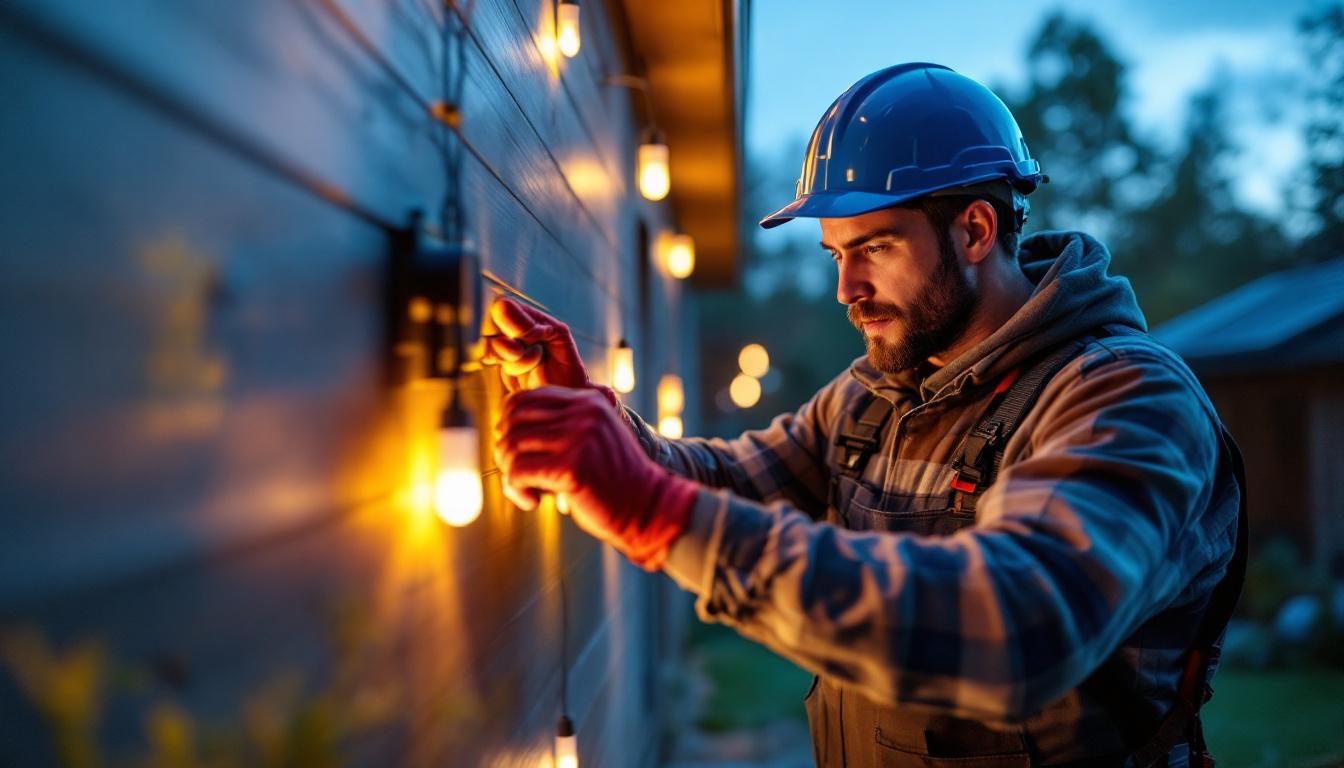
As the demand for energy-efficient and environmentally friendly lighting solutions continues to grow, outdoor LED strip solar lighting has emerged as a popular choice among homeowners and businesses alike. However, despite its advantages, many lighting contractors make common mistakes that can hinder the effectiveness and longevity of these installations. This article aims to highlight these pitfalls and provide insights on how to avoid them, ensuring that projects are completed successfully and to the satisfaction of clients.
Before delving into the common mistakes, it is essential to understand what outdoor LED strip solar lighting entails. These systems typically consist of LED strips powered by solar panels, allowing for illumination without relying on traditional electrical sources. They are ideal for various applications, including garden lighting, pathway illumination, and decorative features. The technology behind these lights has evolved significantly, making them more efficient and durable than ever before. With advancements in solar panel efficiency and LED technology, users can now enjoy brighter lights with longer operational hours, even on cloudy days.
Outdoor LED strip solar lighting offers numerous benefits. First and foremost, it is energy-efficient, utilizing solar power to reduce electricity costs. Additionally, these systems are often easy to install, requiring minimal tools and expertise. They are also environmentally friendly, contributing to sustainability efforts by reducing carbon footprints. Moreover, many models come equipped with features such as motion sensors and timers, allowing for enhanced security and convenience. This means that not only do they light up your outdoor space, but they can also deter potential intruders by illuminating areas when movement is detected.
These lighting solutions are versatile and can be used in various settings. From illuminating walkways and patios to enhancing landscaping features, outdoor LED strip solar lights can transform any outdoor space. Their adaptability makes them a go-to choice for many contractors looking to provide clients with innovative lighting solutions. Furthermore, they can be used creatively in events and gatherings, providing ambient lighting for outdoor parties or weddings. By strategically placing these lights along fences, trees, or garden beds, homeowners can create a magical atmosphere that enhances the beauty of their surroundings while ensuring safety and visibility for guests.
Despite the advantages of outdoor LED strip solar lighting, many contractors fall into common traps that can compromise the success of their projects. Understanding these mistakes is crucial in order to avoid them and ensure high-quality installations.
One of the most significant errors contractors make is failing to conduct a thorough site assessment. Understanding the specific characteristics of the installation site is paramount. Factors such as sunlight exposure, shading from trees or buildings, and geographical location can significantly impact the performance of solar-powered lighting.
Contractors should evaluate the area throughout the day to determine the best locations for solar panels. Inadequate sunlight can lead to insufficient charging, resulting in dim or non-functional lights at night. A comprehensive site assessment can help identify optimal placements that maximize solar exposure. Moreover, considering seasonal variations in sunlight can also play a critical role; for instance, areas that receive ample sunlight in summer may experience significant shading in winter, affecting the overall efficiency of the lighting system.
Another common mistake is overlooking the quality of the materials used in the installation. Not all outdoor LED strip solar lights are created equal. Using low-quality components can lead to premature failures and unsatisfactory performance.
Contractors should prioritize sourcing high-quality LED strips and solar panels that are designed for outdoor use. Weather-resistant materials and reliable batteries are essential for ensuring longevity and functionality. Investing in quality materials not only enhances the performance of the lighting system but also builds trust with clients. Furthermore, understanding the warranty and support offered by manufacturers can provide additional peace of mind, ensuring that contractors can address any issues that may arise post-installation without incurring extra costs.
While LED strip solar lights are often marketed as easy to install, improper wiring can lead to significant issues. Contractors sometimes rush through the installation process, neglecting to follow proper wiring protocols. This can result in poor connections, which may cause flickering lights or complete failures.
Taking the time to ensure that all connections are secure and properly insulated is crucial. Additionally, using the correct gauge of wire for the application can prevent overheating and potential hazards. A meticulous approach to wiring can save time and resources in the long run. It is also beneficial for contractors to familiarize themselves with local electrical codes and regulations, as adhering to these standards not only enhances safety but also ensures compliance, which can be critical for project approvals and inspections. Regular training and updates on best practices in wiring can further empower contractors to avoid these pitfalls and deliver superior installations.
In addition to common mistakes, certain installation techniques can undermine the effectiveness of outdoor LED strip solar lighting. Understanding these techniques can help contractors refine their approach and achieve better results.
One frequently overlooked step is testing the system before completing the installation. Contractors may assume that everything will function correctly based on specifications, but testing is essential to ensure that all components work as intended.
Before finalizing the installation, it is advisable to test the lights in situ. This allows contractors to identify any issues, such as insufficient brightness or malfunctioning components, and address them before the project is completed. Taking this extra step can prevent costly callbacks and enhance customer satisfaction.
Outdoor lighting systems must be designed to withstand seasonal changes. Contractors sometimes install solar lights without considering how weather variations can affect performance. For example, during winter months, shorter days and inclement weather can reduce sunlight exposure and battery performance.
To mitigate these issues, contractors should select solar lights with adjustable settings or additional battery capacity to ensure reliable performance throughout the year. Additionally, educating clients about seasonal maintenance can help them keep their systems functioning optimally.
Another mistake that contractors often make is failing to familiarize themselves with local regulations regarding outdoor lighting. Many municipalities have specific guidelines governing the installation of outdoor lighting, including restrictions on brightness levels and light pollution.
Before commencing a project, contractors should research and comply with local regulations to avoid potential fines or required modifications. This proactive approach not only ensures compliance but also demonstrates professionalism and respect for the community.
Effective communication with clients is critical to the success of any lighting project. However, many contractors overlook this aspect, leading to misunderstandings and dissatisfaction. Here are some common pitfalls in client communication.
Setting realistic expectations is crucial when discussing project timelines and outcomes. Contractors sometimes promise quick installations or overly bright lighting without considering the limitations of solar technology. This can lead to disappointment when the final results do not align with client expectations.
To avoid this, contractors should provide clear information about what clients can realistically expect from their solar lighting systems. Discussing factors such as charging times, brightness levels, and maintenance requirements can help set a more accurate picture and foster trust.
Once the installation is complete, clients may be unsure about how to maintain their new lighting systems. Failing to provide maintenance guidance can lead to issues down the line, such as reduced performance or premature failure of components.
Contractors should take the time to educate clients on best practices for maintaining their outdoor LED strip solar lighting. This may include tips on cleaning solar panels, checking connections, and seasonal adjustments. Providing this information can enhance client satisfaction and promote long-term functionality.
As technology continues to evolve, it is essential for contractors to consider future-proofing their installations. This involves selecting systems that can adapt to advancements in solar technology and changing client needs.
Investing in modular solar lighting systems can provide flexibility for future upgrades. These systems allow for easy expansion or modification, accommodating changes in client preferences or advancements in technology.
Contractors should discuss the benefits of modular systems with clients, highlighting how they can adapt to future needs without requiring a complete overhaul. This forward-thinking approach can enhance the value of the installation and promote long-term client relationships.
Keeping abreast of the latest advancements in solar technology is vital for contractors aiming to provide the best solutions for their clients. New developments can lead to improved efficiency, longer battery life, and enhanced features.
Contractors should invest time in ongoing education and training to stay informed about emerging trends in outdoor LED strip solar lighting. This knowledge can empower them to make informed recommendations and maintain a competitive edge in the market.
Outdoor LED strip solar lighting presents an exciting opportunity for lighting contractors to offer innovative and sustainable solutions to their clients. However, avoiding common mistakes is essential to ensure successful installations and satisfied customers. By conducting thorough site assessments, using quality materials, implementing proper installation techniques, and maintaining effective communication, contractors can enhance their projects and build lasting relationships with clients.
As the industry continues to evolve, staying informed about technological advancements and best practices will further empower contractors to deliver exceptional results. By embracing these strategies, lighting contractors can position themselves as leaders in the outdoor LED strip solar lighting market, ultimately benefiting both their businesses and their clients.
Ready to elevate your lighting projects with the best in solar LED technology? Look no further than LumenWholesale for all your outdoor LED strip solar lighting needs. Our spec-grade products promise top-notch quality and performance, ensuring your installations shine above the rest. With unbeatable wholesale prices and the convenience of free shipping on bulk orders, you can trust us to provide the value and reliability you need to succeed. Don’t let inflated markups dim your project’s potential. Choose LumenWholesale and experience Wholesale Lighting at the Best Value today!

Discover how UV light sterilizing is revolutionizing the lighting industry by providing innovative solutions for cleaner and safer environments.
Discover the pivotal role of LED flat panel lighting in modern lighting projects.

Discover the benefits of garden solar powered lights and how they can revolutionize your lighting installation projects.

Discover the essential guide for lighting contractors with our comprehensive checklist on recessed rectangle lights.